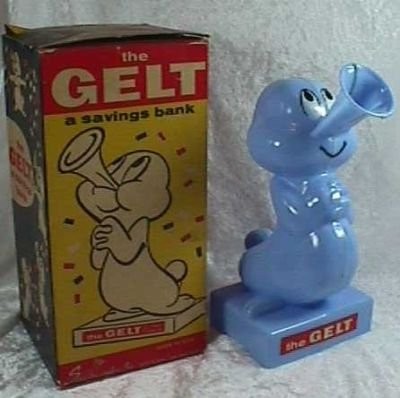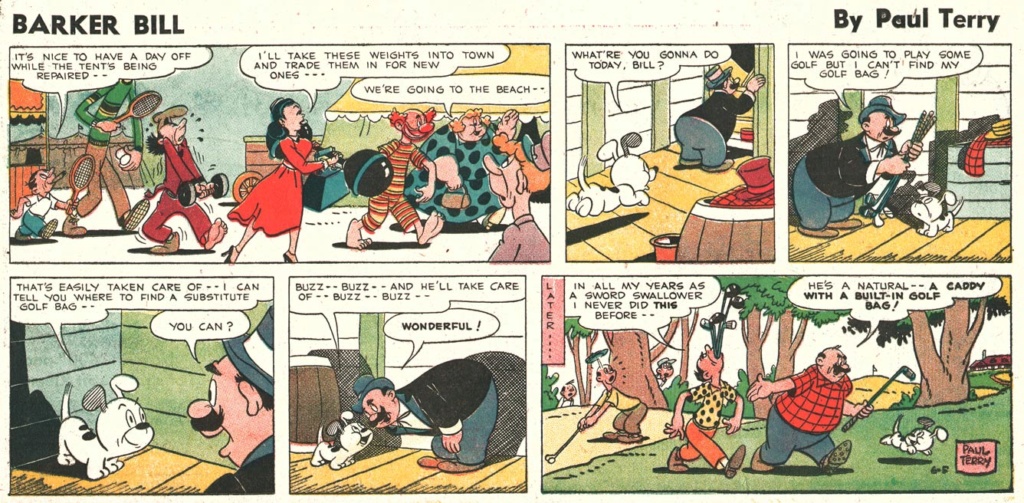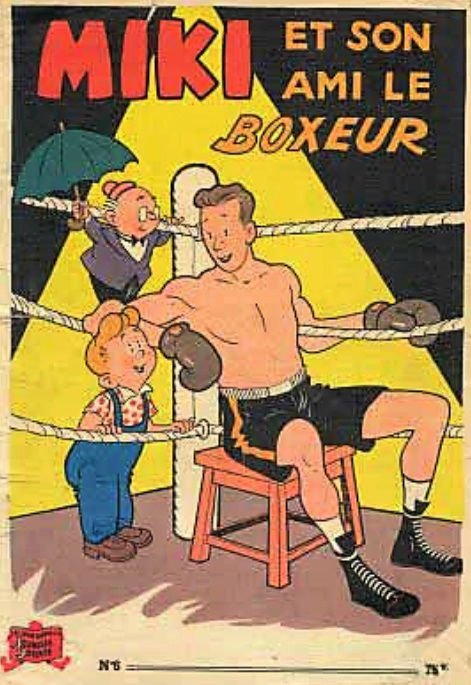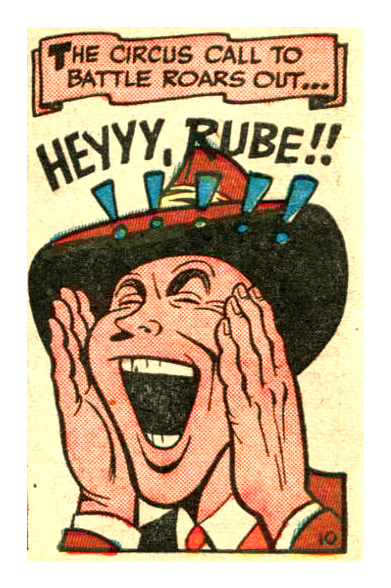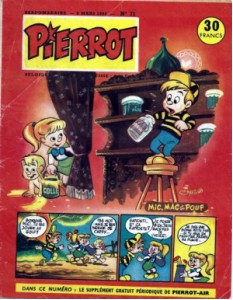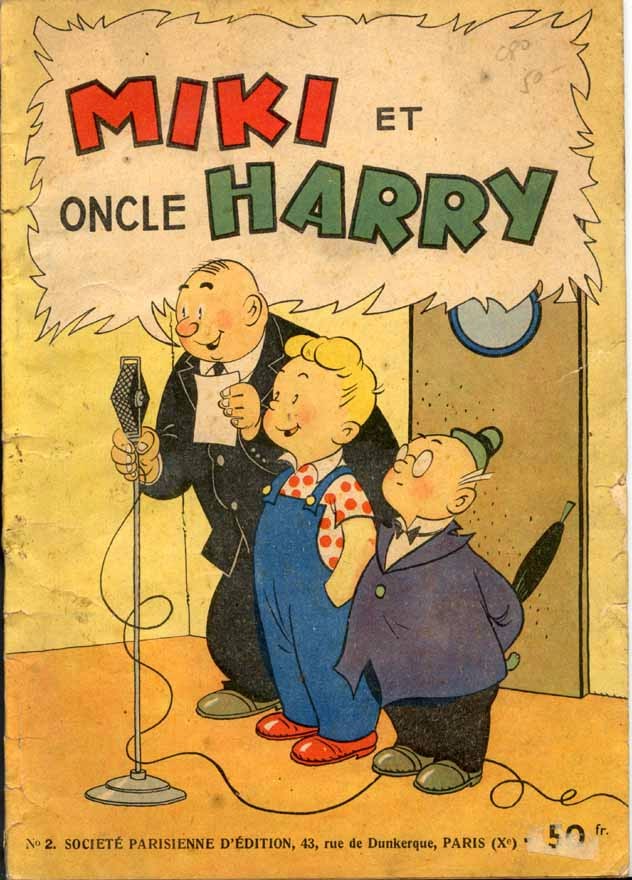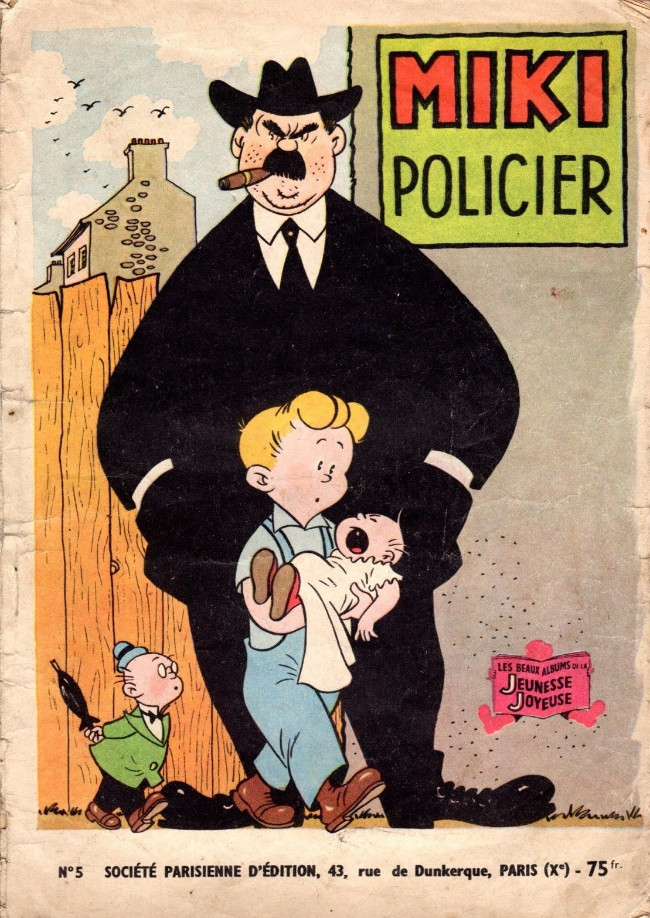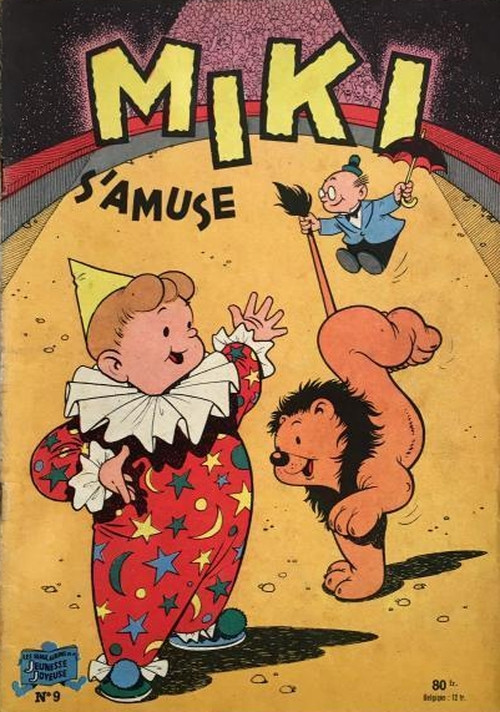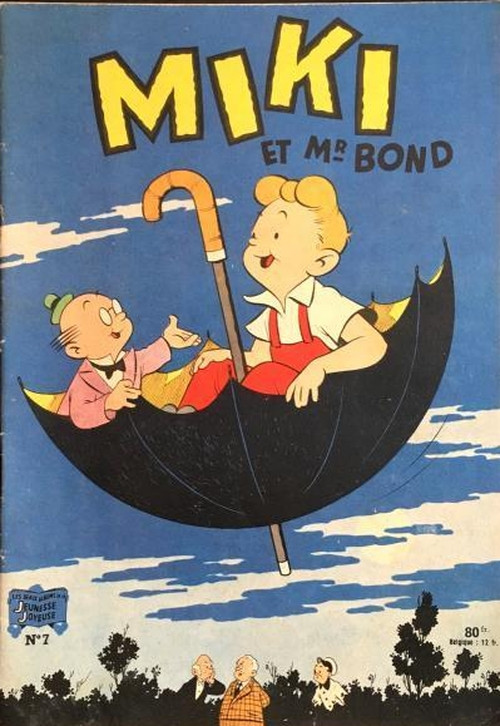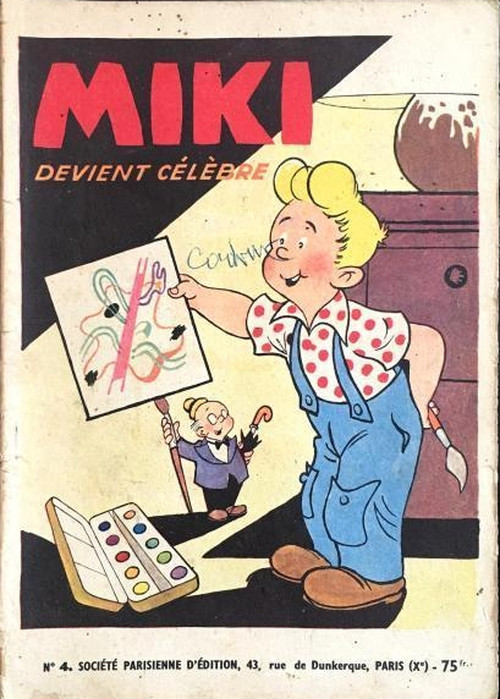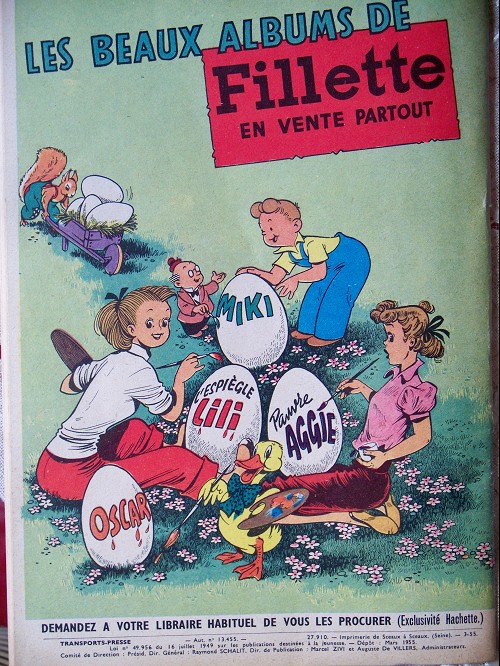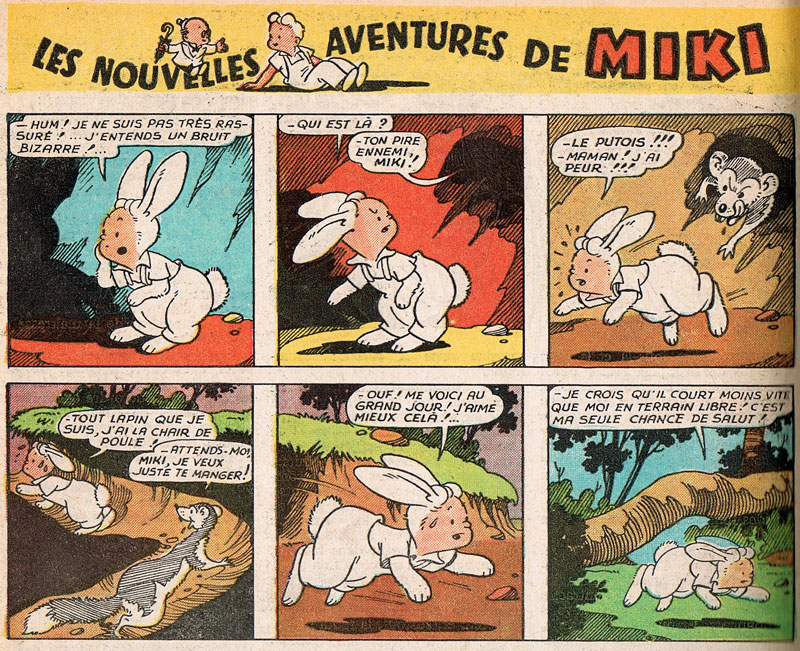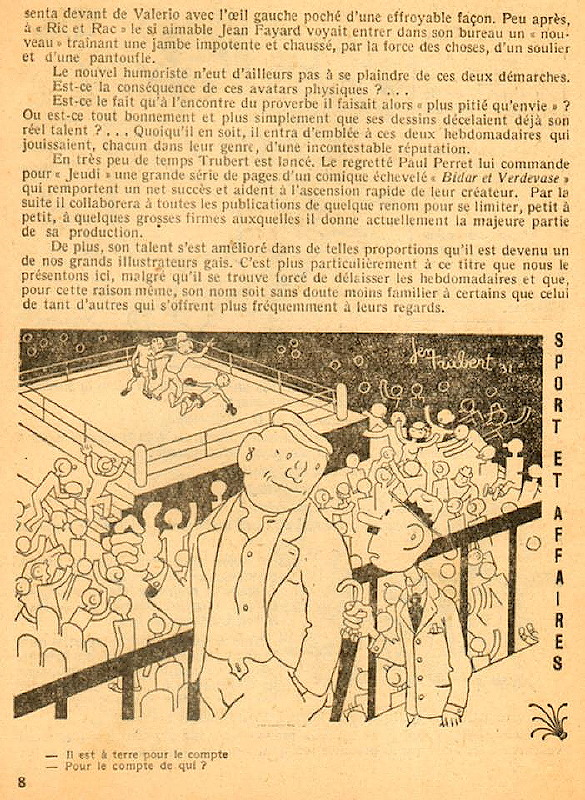Bien oublié mais si mignon :
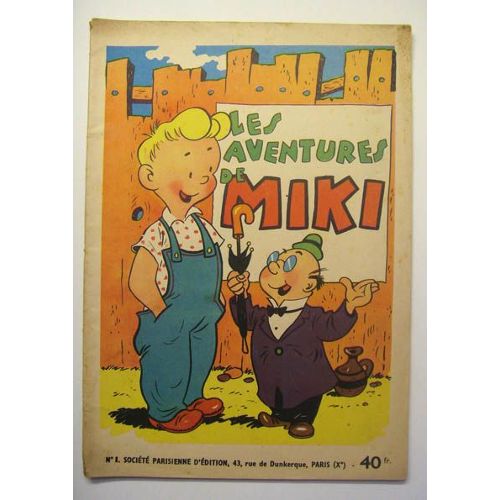
je lui redonne vie un instant...
En France il est né dans FILLETTE :
Fillette après-guerre, première série : 1946-1953 (2ème partie)
17 mai 2016
Par Michel Denni
Au n° 106 de juillet 1948, une nouvelle bande américaine voit le jour.
Il s’agit de « Miki », créé par Bob Kay l’année précédente dans le Geo Matthews Adams Service : un petit garçon dont le père doit se défendre en affaires contre un vieillard riche et avare. Heureusement, il y a oncle Harry, sorte de bon génie invisible qui ne peut être vu que par Miki. Muni d’un parapluie qui lui permet de voler, Harry sait aussi parler aux animaux. Il est de ce fait à l’origine de nombreux gags et farces montées par le petit garçon.
La bande reçut un excellent accueil des jeunes lectrices de l’époque, puisqu’elle parut pendant 277 semaines, de 1948 à 1953, sous la signature de Bob Kay, avant d’être reprise plus tard par Alexandre Gérard. Il existe aussi neuf albums brochés édités par la Société parisienne d’édition, dans la collection Les Beaux Albums de la jeunesse joyeuse, publiés entre 1949 et 1956.
La toute premiére planche :
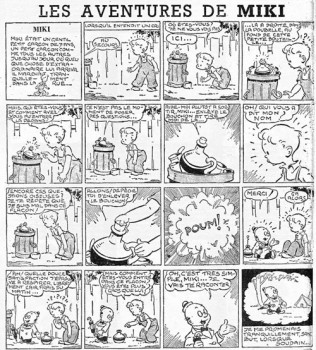
http://www.forumpimpf.net/download/file.php?id=185277&t=1
Bob Kay comme son nom ne l'indique pas était d'origine japonaise et comme tel a fait un séjour en camp pendant W.W.II ;
https://www.bedetheque.com/media/Photos/Photo_45183.jpg
https://www.lambiek.net/artists/k/kuwahara_bob.htm
Centre de Heart Mountain (près de Ralston, Wyoming), 10 800 internés17
Le Heart Mountain Relocation Center (centre de relogement de guerre de Heart Mountain) est un camp d'internement situé dans le nord-ouest du Wyoming. Il ouvre le 11 août 1942. Sa population maximum sera de 10 767 internés (en janvier 1943), ce qui en fit provisoirement la 3e ville du Wyoming en termes de population. Les internés étaient soumis à la conscription militaire, 85 iront en prison pour refus de s'y soumettre et 799 jeunes seront envoyés dans l'armée. Le camp ferme le 10 novembre 1945.
Un bout de bio. trés détaillée mais en anglais :
At NCS, Kuwahara said, "…we finally resettled in Larchmont, N.Y. in 1945. Did a comic strip "Miki" for G.M. Adams Service for 5 years but couldn't pull up it's circulation…gave it up and went to work for Paul Terry in 1950…Paul sold out to C.B.S. in 1955…studio is now known as Terrytoons-CBS…" According to Asian American Art, he lived in New Rochelle, New York, from 1945 to 1950, before settling in Larchmont. Terry's name was credited to the comic strip Barker Bill, but it was ghosted by Kuwahara. The Winnipeg Free Press published the strip beginning September 27, 1954 (below). Tralfaz has the first week here. Mark Kausler's CatBlog has more strips here and here. (Use the search box for more Barker Bill strips.)
On December 24, 1955, Editor & Publisher announced the five winners in "United Feature Syndicate's $10,000 Talent Comics Contest." Kuwahara's Marvelous Mike was one of them. Also a winner was Little Brave by Thomas Okamoto, who was interned at the Santa Anita Assembly Center. When the Sunday Herald (Connecticut), February 12, 1956, reported the winners of the contest, Okamoto used the pseudonym, Tom Mako. Marvelous Mike strips can be viewed here (first two weeks) and here (final week). Mark Kausler's CatBlog has the entire run of Marvelous Mike. It begins here and continues for 75 post
Asian American Art said, "He created the Hashimoto Mouse character that appeared in the theatrical release of Hashimoto-san (1959) and directed episodes of the animated television cartoon series Hashimoto Mouse (1959–1963). He also directed episodes of Deputy Dawg." Hashimoto-san is discussed at the Nishikata Film Review. His filmography is at the Internet Movie Database.
Lastly at NCS, Kuwahara said about himself, "…Hobby: Golf, what else?…Sport: Golf, What else? Most frustrating game I know…but, dammit, I love it!!" He passed away December 10, 1964, in Larchmont, according to Asian American Art. The Social Security Death Index said his wife passed away September 20, 1996. The couple were among the over one million names placed on the STARDUST
# posted by Alex Jay @ 8:00 AM
Comments:
The situation for Bob Kuwahara was different than for most Japanese-American internees. Because he was born in Tokyo he not only wasn't a US citizen, he couldn't become a US citizen under the Naturalization Act of 1790 which restricted naturalization to "free White persons of good character." Thus, unlike most of the people interred on the west coast, he technically really was an enemy alien since he born in Japan of Japanese parents.
Les 9 albums de 1949 à 1955 :
http://www.bd-nostalgie.org/ALBUMS/04_MIKI.HTM
Ce dessin particulièrement "mignon" reste néanmoins très expressif et malgré le thème magique la réalité des aspects de l'amérique d'après guerre me parait bien rendue .
 MIKI
MIKI 

je lui redonne vie un instant...
En France il est né dans FILLETTE :
Fillette après-guerre, première série : 1946-1953 (2ème partie)
17 mai 2016
Par Michel Denni
Au n° 106 de juillet 1948, une nouvelle bande américaine voit le jour.
Il s’agit de « Miki », créé par Bob Kay l’année précédente dans le Geo Matthews Adams Service : un petit garçon dont le père doit se défendre en affaires contre un vieillard riche et avare. Heureusement, il y a oncle Harry, sorte de bon génie invisible qui ne peut être vu que par Miki. Muni d’un parapluie qui lui permet de voler, Harry sait aussi parler aux animaux. Il est de ce fait à l’origine de nombreux gags et farces montées par le petit garçon.
La bande reçut un excellent accueil des jeunes lectrices de l’époque, puisqu’elle parut pendant 277 semaines, de 1948 à 1953, sous la signature de Bob Kay, avant d’être reprise plus tard par Alexandre Gérard. Il existe aussi neuf albums brochés édités par la Société parisienne d’édition, dans la collection Les Beaux Albums de la jeunesse joyeuse, publiés entre 1949 et 1956.
La toute premiére planche :

http://www.forumpimpf.net/download/file.php?id=185277&t=1
Bob Kay comme son nom ne l'indique pas était d'origine japonaise et comme tel a fait un séjour en camp pendant W.W.II ;

https://www.bedetheque.com/media/Photos/Photo_45183.jpg
https://www.lambiek.net/artists/k/kuwahara_bob.htm

Centre de Heart Mountain (près de Ralston, Wyoming), 10 800 internés17
Le Heart Mountain Relocation Center (centre de relogement de guerre de Heart Mountain) est un camp d'internement situé dans le nord-ouest du Wyoming. Il ouvre le 11 août 1942. Sa population maximum sera de 10 767 internés (en janvier 1943), ce qui en fit provisoirement la 3e ville du Wyoming en termes de population. Les internés étaient soumis à la conscription militaire, 85 iront en prison pour refus de s'y soumettre et 799 jeunes seront envoyés dans l'armée. Le camp ferme le 10 novembre 1945.
Un bout de bio. trés détaillée mais en anglais :
At NCS, Kuwahara said, "…we finally resettled in Larchmont, N.Y. in 1945. Did a comic strip "Miki" for G.M. Adams Service for 5 years but couldn't pull up it's circulation…gave it up and went to work for Paul Terry in 1950…Paul sold out to C.B.S. in 1955…studio is now known as Terrytoons-CBS…" According to Asian American Art, he lived in New Rochelle, New York, from 1945 to 1950, before settling in Larchmont. Terry's name was credited to the comic strip Barker Bill, but it was ghosted by Kuwahara. The Winnipeg Free Press published the strip beginning September 27, 1954 (below). Tralfaz has the first week here. Mark Kausler's CatBlog has more strips here and here. (Use the search box for more Barker Bill strips.)
On December 24, 1955, Editor & Publisher announced the five winners in "United Feature Syndicate's $10,000 Talent Comics Contest." Kuwahara's Marvelous Mike was one of them. Also a winner was Little Brave by Thomas Okamoto, who was interned at the Santa Anita Assembly Center. When the Sunday Herald (Connecticut), February 12, 1956, reported the winners of the contest, Okamoto used the pseudonym, Tom Mako. Marvelous Mike strips can be viewed here (first two weeks) and here (final week). Mark Kausler's CatBlog has the entire run of Marvelous Mike. It begins here and continues for 75 post
Asian American Art said, "He created the Hashimoto Mouse character that appeared in the theatrical release of Hashimoto-san (1959) and directed episodes of the animated television cartoon series Hashimoto Mouse (1959–1963). He also directed episodes of Deputy Dawg." Hashimoto-san is discussed at the Nishikata Film Review. His filmography is at the Internet Movie Database.
Lastly at NCS, Kuwahara said about himself, "…Hobby: Golf, what else?…Sport: Golf, What else? Most frustrating game I know…but, dammit, I love it!!" He passed away December 10, 1964, in Larchmont, according to Asian American Art. The Social Security Death Index said his wife passed away September 20, 1996. The couple were among the over one million names placed on the STARDUST
# posted by Alex Jay @ 8:00 AM
Comments:
The situation for Bob Kuwahara was different than for most Japanese-American internees. Because he was born in Tokyo he not only wasn't a US citizen, he couldn't become a US citizen under the Naturalization Act of 1790 which restricted naturalization to "free White persons of good character." Thus, unlike most of the people interred on the west coast, he technically really was an enemy alien since he born in Japan of Japanese parents.
Les 9 albums de 1949 à 1955 :
http://www.bd-nostalgie.org/ALBUMS/04_MIKI.HTM
Ce dessin particulièrement "mignon" reste néanmoins très expressif et malgré le thème magique la réalité des aspects de l'amérique d'après guerre me parait bien rendue .
 MIKI
MIKI 
Dernière édition par 2J le Ven 10 Aoû - 10:17, édité 2 fois
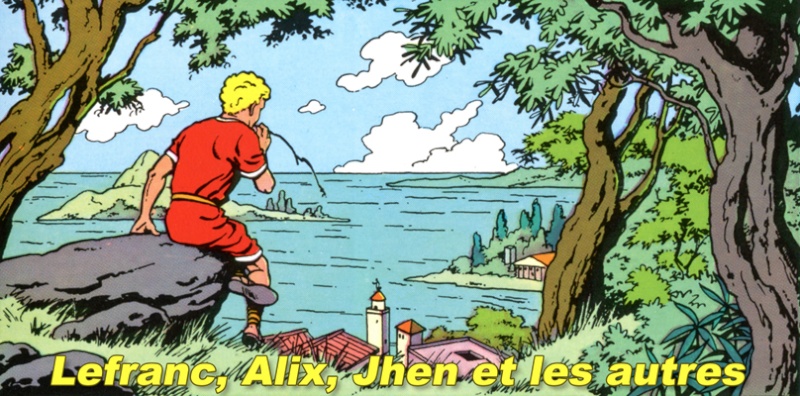
 Accueil
Accueil






